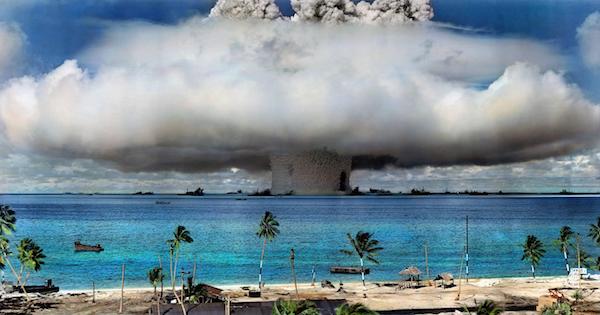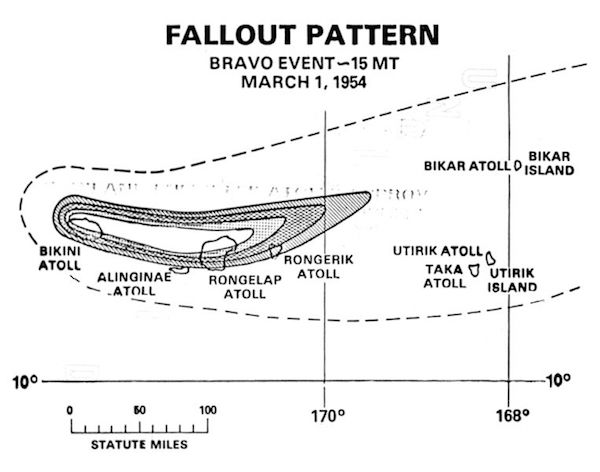March 1st is Nuclear Remembrance Day. This is a Marshallese national holiday and is observed on the day of that the Bravo bomb was detonated, March 1st, 1954.
After World War II the Marshall Islands became a US Territory and the US decided to use the Marshall Islands for testing of Nuclear devices.
The Marshall Islands, specifically Bikini atoll, were chosen for nuclear testing for several reasons.
- It was geographically isolated and was thousands of miles from common oceanic routes and other world powers.
- It was protected by American forces and could prevent any foreigners from observing nuclear testing.
- Testing could be conducted without endangering American citizens.
- Bikini had a lagoon large enough for a fleet of Naval vessels.
- Bikini was only inhabited by a small population of 167 people who could be easily relocated.
In the early years after World War II the full negative effects of nuclear weapons were not fully understood by the public. It was during this era that the Bikini bathing suit was invented and it was named after Bikini Atoll. At the unveiling of the bikini, designer Louis Reard, stated “Like the bomb, the bikini is small and devastating.”
Once the Marshall Islands were chosen, beginning in 1946 the United States over a span of 12 years detonated 67 nuclear bombs, 23 of these bombs were on Bikini atoll alone. The explosive power of these nuclear detonations was equivalent to detonating a 1.6 Hiroshima sized bomb EVERY day for the 12 years of active testing or for a total of 8,000+ Hiroshima sized bombs.
Bravo Bomb
On March 1, 1954, the largest bomb code named “Bravo” was detonated at Bikini Atoll. The Bravo bomb as equivalent to 17 megatons of TNT, 1,300 times more destructive than Hiroshima and was specifically designed to create vast amounts of radioactive fallout. The explosion shook islands 250 miles away, created a fireball 4 miles wide and vaporized 3 islands on the atoll. Prior to the Bravo test, the policy had been for routine evacuation of neighboring islands, but no warnings or evacuations were offered for the Bravo test, despite the U.S. knowing the wind had shifted. This placed Marshallese communities directly in the path of nuclear fallout.
Three to four hours after the blast, the 64 inhabitants of neighboring Rongelap Atoll watched in wonder as the snowflake like ash from Bravo began to fall on their island, reaching a depth of 2 inches. The children played in it. People drank water saturated with it. Soon they began to experience vomiting and diarrhea, their eyes burned and their necks, arms and legs swelled. It would take two days before the US sent in a navy ship to evacuate the islanders and give them medical attention. By then the 64 people were all suffering acute radiation poisoning, with burns covering their bodies. Many would later suffer from thyroid cancers, leukemia and fertility problems. No explanation has ever been giving as to why no one was evacuated during the Bravo tests.
The final nuclear tests were conducted on Bikini on July 22, 1958. Almost 60 years later, the people of Bikini Atoll remain unable to return to Bikini and remain scattered throughout the Marshall Islands as testing of their Atoll still shows unsafe levels of radiation.


Bravo Fallout map 1954
References:
Etto n̄an Raan Kein: A Marshall Islands History. by Julianne M. Walsh, Ph.D.; in collaboration with Hilda C. Heine, Ed.D.; with the assistance of Carmen Milne Bigler, Mark Stege. 2012. 526 pp.
For the Good of Mankind: A History of the People of Bikini and their Islands. by Jack Niedenthal. 2nd ed. 2013. 180 pp.
Day of Two Suns: U.S. Nuclear Testing and the Pacific Islanders. by Jane Dibblin. 1990. 299 pp.
Paradise with an Asterisk. by S.C. Gwynne. Outside Magazine, October 2012. https://www.outsideonline.com/1905076/paradise-asterisk
